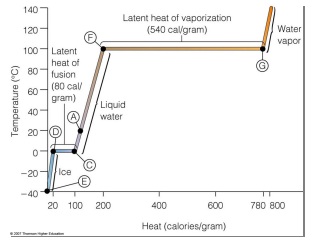Assignment:
For this homework, the concept of "Density" and "Heat" will be explored.
Density is the "compactness" of a material, or stated in a formula it is how much it weighs (mass) divided by how much space it takes up (volume). For pure water the density is 1 gram for every milliliter of water (1 g/ml). From the table below, determine what elements are described in Questions 1-3.
|
Name of element
|
Density (g/ml)
|
|
Magnesium
|
1.74
|
|
Silicon
|
2.33
|
|
Bismuth
|
9.80
|
|
Zinc
|
7.14
|
|
Sodium
|
0.97
|
|
Boron
|
2.34
|
1. Item weighs 25 grams and takes up 3.5 ml of volume _______________
2. Item weighs 117 grams and takes up 50 ml of volume _______________
3. This item floats on water ___________________
4. If all these items were mixed together, which one is expected to sink to the bottom? ________
"Heat" is the next topic. It is a somewhat difficult concept to grasp but it is very important. I encourage you first to read Chapter 5. Then carefully study the next figure. This figure is a graph that plots temperature over thermal energy. To answer questions 9-12 you need to read, use this graph. No formula is needed!

There are two general types of heat; "Sensible" and "Latent." Sensible Heat describes a process where thet emperature changes as heat is added or removed. Latent Heat Thermal Energy is absorbed but the temperature does not change, for example between points D and C shown in the graph.
The definition of "Heat Capacity" plays a significant role in sensible heat; it is the ability of a substance to store heat. For pure water, the heat capacity is 1 cal / g °C (1 calorie per every gram of water per every degree change in Celsius), or in words; if I have 1 gram of water and I want to raise it 1°C, I must add 1 Calorie of heat. Determine the following:
5. If I want to raise 2 grams of water 1°C, how much heat should I add? _____________
6. If I want to raise 1 gram of water 2°C, how much heat should I add? _____________
The higher the ‘heat capacity' of an object, the more heat it takes to increase its temperature. Determine the following:
7. Wood has 4 times the heat capacity as steel. If I add the same amount of heat to the same amount of steel and wood, I find the temperature of the steel increases to 40°C. What is the temperature of the wood? ___________
8. Water has 5 times the heat capacity as soil. If I add the same amount of heat to the same amount of water and soil, I find the temperature of the soil increases to 50°C. What is the temperature of the water? _________
The next concept to be considered when dealing with heat, is "Latent Heat". The word latent refers to the temperature of the system remaining the same even as heat is being added or subtracted from it. This will occur when the system is changing states. Consider a piece of ice.
9. The latent heat of fusion (or the amount of heat required to turn the ice into water) is 80 Calories/gram. How much heat must be added to melt 2 grams of ice at 0°C and what is the final temperature after this heat is added? _______________ _______________
10. The latent heat of vaporization (or the amount of heat required to turn the water into a vapor) is 540 Calories/gram. How much heat must be added to turn 3 grams of water at 100°C into a vapor and what will be the final temperature after this much heat is added? _____________ _____________
Putting sensible and latent heat together, it is now possible to figure out the temperature of water going through various stages of heat input/withdrawal. (Heat capacity of water is 1 cal / g °C)
11. 60 calories is added to 1 gram of water at an initial temperature of 80°C. What is the water's final temperature and state (solid, liquid or vapor)?
Temperature = __________________
State = ________________________
12. 120 calories is removed from 1 gram of water at an initial temperature of 40°C. What is the water's final temperature and state (solid, liquid or vapor)?
Temperature = __________________
State = ________________________